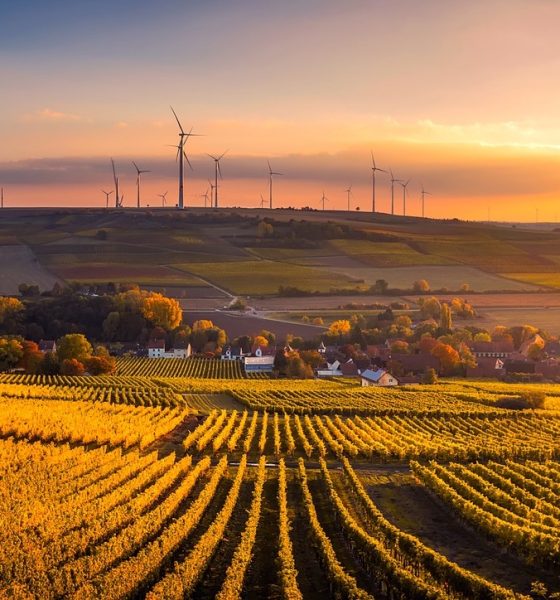

Lifestyle
Inventor that harvested fresh water from the sky wins XPRIZE competition
At the annual Visioneering 2018 gathering in Los Angeles, the team at XPRIZE formally announced their grand prize Water Abundance competition winner: Skysource/Skywater Alliance, a company now $1.5 million dollars richer for developing a sustainable way to harvest drinking water from the sky.
The rules of the competition were strict: The teams’ devices had to extract 2,000 liters of water from the air per day using 100% renewable energy for a maximum of two cents per liter. Rising to the challenge of the narrow parameters, 98 teams submitted proposals, and five had ideas that made it to the final round before the winner was chosen after the two-year time frame allotted for development.
Having an on-demand water supply anywhere air is available may sound like a cool idea in itself, but why exactly was XPRIZE involved in making the idea arguably even better?
The scene has already been set in numerous cartoons and films: It’s hot, the middle of nowhere (most likely a desert), and the main character is in desperate need of water. Then, suddenly, an oasis appears in the distance, offering the salvation of a beautiful body of blue liquid complete with a palm tree for shade. As in many of those same scenarios where the oasis turns out to be a mirage, such a water supply doesn’t exist in underprivileged parts of the world. More than that, according to Water.org, there’s a scarcity that has grown to the tune of 844 million people living without access to safe drinking water. The team at XPRIZE took up this issue head-on with this competition, the oases being akin to the competitors’ devices.
As amazing as the concept of harvesting water from the sky is, it’s not new technology. With directly relevant patents dating back to at least 1926 (U.S. Patent No. 1,816,592), innovation-minded people have long recognized that, since the air we breathe is full of the same molecules that make up what we drink, there should be an easy way to tap into it via engineering. After all, grade school science classes taught us about the liquid-to-gas transformation of H2O (as does forgetting about boiling water on the stove), so the reverse concept of an air-to-water device might seem plausible.
If you live in a region where rainy seasons and basements co-exist, the workings of a dehumidifier may have also crossed your mind while contemplating the concept of removing moisture from the air. Also, even the winner of the XPRIZE Water Abundance competition owns multiple patents directed to this technology and is already in the marketplace with their Atmospheric Water Generation (AWG) products, or rather, manufactured “rainwater in a box”. It has even had celebrity clients to date and has been providing its technology to governments, militaries, and emergency relief efforts around the world.
So, why then, was this idea in need of a million-dollar-plus prize?
The difference brought on by the XPRIZE was the accessibility of the technology. Namely, the high energy needs of the systems historically put areas without access to such energy at a great disadvantage towards tapping into its potential. Skysource/Skywater Alliance made a key development to meet the requirements of the competition in adapting their products to produce water via sustainable, low-cost power methods like solar panels and biomass gasifiers. As specified, their modified devices operate on 100% renewable, affordable energy sources.
Thanks to motivation brought on by the Water Abundance competition, clean drinking water may soon be within reach of populations at most risk from water shortages. As for the rest, moving a little more in the direction of sustainability for consumables is a win-win for all.

Lifestyle
Tesla Model S Plaid battles China’s 1500 hp monster Nurburgring monster, with surprising results
There is just something about Tesla’s tuning and refinement that makes raw specs seem not as game-changing.

The Tesla Model S Plaid has been around for some time. Today, it is no longer the world’s quickest four-door electric sedan, nor is it the most powerful. As per a recent video from motoring YouTube channel Carwow, however, it seems like the Model S Plaid is still more than a match for some of its newer and more powerful rivals.
The monster from China
The Xiaomi SU7 Ultra is nothing short of a monster. Just like the Model S Plaid, it features three motors. It also has 1,548 hp and 1,770 Nm of torque. It’s All Wheel Drive and weighs a hefty 2,360 kg. The vehicle, which costs just about the equivalent of £55,000, has been recorded setting an insane 7:04.957 at the Nurburgring, surpassing the previous record held by the Porsche Taycan Turbo GT.
For all intents and purposes, the Model S Plaid looked outgunned in Carwow’s test. The Model S Plaid is no slouch with its three motors that produce 1,020 hp and 1,420 Nm of torque. It’s also a bit lighter at 2,190 kg despite its larger size. However, as the Carwow host pointed out, the Model S Plaid holds a 7:25.231 record in the Nurburgring. Compared to the Xiaomi SU7 Ultra’s record, the Model S Plaid’s lap time is notably slower.
Real-world tests
As could be seen in Carwow’s drag races, however, Tesla’s tech wizardry with the Model S Plaid is still hard to beat. The two vehicles competed in nine races, and the older Model S Plaid actually beat its newer, more powerful counterpart from China several times. At one point in the race, the Xiaomi SU7 Ultra hit its power limit due to its battery’s temperature, but the Model S Plaid was still going strong.
The Model S Plaid was first teased five years ago, in September 2020 during Tesla’s Battery Day. Since then, cars like the Lucid Air Sapphire and the Xiaomi SU7 Ultra have been released, surpassing its specs. But just like the Model Y ended up being the better all-rounder compared to the BYD Sealion 7 and the MG IM6, there is just something about Tesla’s tuning and refinement that makes raw specs seem not as game-changing.
Check out Carwow’s Model S Plaid vs Xiaomi SU7 drag race video below.
Lifestyle
500-mile test proves why Tesla Model Y still humiliates rivals in Europe
On paper, the BYD Sealion 7 and MG IM6 promised standout capabilities against the Model Y.

BYD is seeing a lot of momentum in Europe, so much so that mainstream media has taken every opportunity to argue that the Chinese automaker has beaten Tesla in the region. But while BYD sales this year in Europe are rising and Tesla’s registrations remain challenged, the raw capabilities of vehicles like the Model Y are difficult to deny.
This was highlighted in a 500-mile challenge by What Car? magazine, which showed that the new Tesla Model Y is more efficient, cheaper to run, and more reliable than rivals like the BYD Sealion 7, and even the nearly 400 KW-charging MG IM6.
Range and charging promises
On paper, the BYD Sealion 7 and MG IM6 promised standout capabilities against the Model Y. The Sealion 7 had more estimated range and the IM6 promised significantly faster charging. When faced with real-world conditions, however, it was still the Model Y that proved superior.
During the 500-mile test, the BYD nearly failed to reach a charging stop, arriving with less range than its display projected, as noted in a CarUp report. MG fared better, but its charging speeds never reached its promised nearly-400 kW charging speed. Tesla’s Model Y, by comparison, managed energy calculations precisely and arrived at each stop without issue.
Tesla leads in areas that matter
Charging times from 25% to 80% showed that the MG was the fastest at 17 minutes, while Tesla and BYD were close at 28 and 29 minutes, respectively. Overall efficiency and cost told a different story, however. The Model Y consumed 19.4 kWh per 100 km, compared to 22.2 for MG and 23.9 for BYD. Over the full trip, Tesla’s charging costs totaled just £82 thanks to its supercharger network, far below BYD’s £130 and MG’s £119.
What Car? Magazine’s testers concluded that despite BYD’s rapid sales growth and the MG IM6’s seriously impressive charging speeds, Tesla remains the more compelling real-world choice. The Model Y just offers stability, efficiency, and a proven charging infrastructure through its Supercharging network. And as per the magazine’s hosts, the Model Y is even the cheapest car to own among the three that were tested.
Watch What Car? Magazine’s 500-mile test in the video below.
Lifestyle
Tesla Cybertruck slapped with world’s least intimidating ticket, and it’s pure cringe
One cannot help but cringe and feel second-hand embarrassment at the idea of a person just driving around with a stack of these babies.

A Cybertruck parked at Stanford Shopping Center in California was recently hit with what might be the most try-hard piece of paper ever slipped under a wiper blade: a “fake citation” accusing the driver of supporting a “fascist car.”
The note, shared on X by Tesla staff program manager Ryan Torres, quickly made the rounds on X, where it quickly gained attention as an example of how not to protest.
The world’s least intimidating ticket
According to the citation, the supposed “violation” was “driving a fascist car.” The remedial action? Take the bus, call an Uber, or ride a bike. The note also dubbed Elon Musk a “chainsaw-wielding Nazi billionaire.” Now, protests against Tesla and Elon Musk have become commonplace this year, but one cannot help but cringe and feel second-hand embarrassment at the idea of a person just driving around with a stack of fake anti-Tesla/Musk citations.
Torres pointed out the irony himself in his post on X. Tesla currently employs over 140,000 Americans, and SpaceX has put the U.S. firmly back at the top of space technology. As Torres put it, maybe the person behind the world’s least intimidating ticket should “read a book on innovation before vandalizing” other people’s property.
Peak performative clownery
Not to mention that the fake ticket’s logic collapses under its own weight. EVs like the Cybertruck are literally designed to reduce emissions, not “destroy the economy.” If anything, Tesla has bolstered the United States’ economy by fueling jobs in engineering, manufacturing, and clean energy. It’s not the first time a Tesla has been the target of vandalism or politically charged notes, but this one stands out for sheer cringe value.
Torres summed it up neatly: “Peak clownery.” On that point, at least, the citation earns full marks. In a way, though, perhaps cringe fake tickets are not as bad as the literal firebombs that were being thrown at Tesla stores and cars earlier this year because some critics were gleefully misinformed about Elon Musk.








